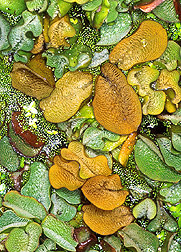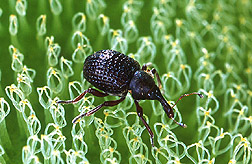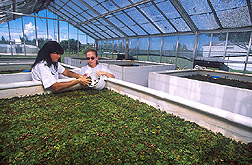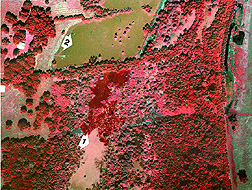Attack on Giant Salvinia
|
|
|
|
In ponds, lakes, and reservoirs from North Carolina to Hawaii, a stealthy invader called giant salvinia is making an unwanted appearance. This free-floating fern has earned a reputation as one of the world's worst aquatic weeds—and with good reason. When conditions are right, salvinia's small, oval leaves form dense mats—green, yellow-green, or brown—that can easily double in size in just a few days.
Sometimes 2 feet thick or more, the mats can cover the surface of an entire pond or small lake, blocking out sunlight that other plants need. And the mats use up oxygen that fish, insects, and other aquatic dwellers require. Giant salvinia, orSalvinia molesta, is a bother to humans as well. It ruins conditions for fishing, boating, and waterskiing. The weed also clogs irrigation and electrical generating systems. ARS scientists in the United States and Australia are working to stop this pest before it wreaks further havoc. Researchers based at ARS labs in Fort Lauderdale and Gainesville, Florida, and in the Brisbane suburb of Indooroopilly, Australia, are leading new studies of the genetic makeup and plant-eating prowess of tiny, salvinia-hungry weevils. |
|
|
Finding an Agent To Eat It Up
Biological control—the use of natural enemies to undermine nonnative organisms such as invasive weeds—is today regarded as the most affordable and practical option for slowing salvinia. ARS researchers were the first in the United States to use a beneficial insect to attack salvinia. They collected the dark-colored, one-tenth-inch-long weevil known asCyrtobagous salviniae from another salvinia species,Salvinia minima, or common salvinia, growing in Florida. Common salvinia is an earlier invader that is now part of the landscape, according to Ted D. Center. He is director of the ARS Invasive Plant Research Laboratory at Fort Lauderdale and Gainesville. The C. salviniae weevil has won kudos internationally for holding salvinia in check. The helpful insect has already been used—with great success—in more than 13 countries over 3 continents. |
|
|
The weevil lives in or on the weed's leaves and submerged stolon- or runner-like structures called rhizomes, says research entomologist Philip W. Tipping of the ARS Invasive Plant Research Laboratory in Fort Lauderdale.
"The adult female," Tipping says, "lays her eggs in a cavity that she creates by chewing into the leaf bud. The larvae that hatch feed on the base of the leaf bud. They eventually tunnel into the rhizomes or sometimes the petioles—the structures that attach the leaves to the stems." The weevil larvae become adults in 17 to 28 days, depending on the weather. Says Tipping, "That means this species is capable of producing a new generation of hungry young in about a month during the warmer parts of the summer. The adults stop laying eggs in the cooler temperatures—the low 70s—in the spring and fall." |
|
|
Tipping and colleagues at the Fort Lauderdale laboratory have collected more than 800 salvinia weevils fromS. minima plants and have turned the insects loose in a salvinia-infested east Texas pond and lake and in a reservoir on the Texas-Louisiana border.
But those releases "were plagued with environmental and human problems," Tipping recounts. "Among other things, we had floods, droughts, and accidental destruction of the salvinia at some experimental sites before the weevils could get their work done." They Look the Same, But They're Not Research on the genetic makeup of the weevils suggests that those collected in Florida might be different from those used in Australia and other parts of the world. "We anticipated that if weevils from overseas and weevils from Florida eventually ended up being used in the United States," says Tipping, "then we would need a reliable way to tell them apart so that we could compare their effectiveness. Under a microscope, they look exactly the same. So we turned to analyses of the weevil's genetic material, or DNA." |
|
|
ARS contracted with the molecular diagnostics laboratory of CSIRO (Commonwealth Scientific and Industrial Research Organization) in Canberra, Australia, to conduct gene sequencing on weevils collected from Florida, Australia, and South Africa. John A. Goolsby, who directs the ARS Australian Biological Control Laboratory in Indooroopilly, was the liaison for this work, conducted by Felice Driver and colleagues at CSIRO.
"Some genetic differences between the Florida weevils and those collected in Australia or South Africa were found," says Tipping, "but we don't yet know how those differences affect the ability of the weevils to thrive on salvinia species. Given the unanswered questions, we decided to release the Australian weevil next. It has a proven track record." Notes Goolsby, "WhenC. salviniae weevils were used in Lake Moondarra here in Australia, they destroyed more than 8,000 tons of giant salvinia in less than a year. Those are the sort of dramatic and rapid results that we're used to seeing from this biological control agent." The Florida scientists also teamed up with colleagues at South Africa's Plant Protection Research Institute in Pretoria to conduct several more tests. Those experiments determined that the Australian weevil, already successfully established in South Africa, won't eat benign North American plants like mosquito fern,Azolla caroliniana, or water clover,Marsilea vestita. "The tests provided additional evidence that the weevils attack only salvinia and won't pester other plants," says Tipping. "We've used these findings, along with other data, in applying for federal and state permission to release the Aussie weevil in Texas and Louisiana. We hope to receive the permit this year." The weevils that the researchers will set free at salvinia-infested sites are descendants of weevils that Goolsby's team in Indooroopilly collected and shipped from Australia. ARS entomologist Gary R. Buckingham, with the Invasive Plant Research Laboratory, has built up a thriving colony of about 7,000 weevils. Salvinia Surveillance In addition to needing a powerful biocontrol agent to knock out giant salvinia, waterway managers also need a fast, affordable way to monitor the weed and detect new infestations before they have a chance to build up. Remote sensing may be the answer. Rangeland scientist James H. Everitt of the ARS Kika de la Garza Subtropical Agricultural Research Center in Weslaco, Texas, teamed up with Texas Parks and Wildlife Department specialists in 1999 to develop remote sensing technology for detecting and monitoring salvinia infestations in the state. Before beginning the salvinia project, Everitt had already started research on remote sensing of two other exotic aquatic weeds in south Texas—water-hyacinth, native to South America, and hydrilla, native to Asia. Everitt began his salvinia research by measuring light reflectance of giant salvinia and other nearby aquatic plants. In some places, giant salvinia was a healthy green. At other sites, growth was so dense that some of the salvinia—starved of nitrogen and other nutrients—turned brown. Everitt found that if the salvinia plants were healthy, their green light-reflectance could be easily distinguished from that of other plants. Densely populated stands with mixtures of various shades of green and brown, however, had similar reflectance to that of alligator-weed, arrowhead, and smartweed. To distinguish dense salvinia from these other plant species, Everitt used near-infrared reflectance. By using color infrared film in the process, he found that both the healthy and the dense giant salvinia infestations could be distinguished from the other species. Now the scientists are researching the potential of combining the aerial color infrared videography with global positioning and geographic information system technologies. The combination would allow the researchers to pinpoint giant salvinia infestations faster and more easily than ground crews could if working on shore or in boats. "That's especially true for infestations in remote, inaccessible locations," says Everitt. "Quick detection of outbreaks before they have a chance to build up is key to stopping the spread of salvinia." Giant salvinia is among the invasive species profiled in a comprehensive database maintained by the ARS National Agricultural Library. Visit it on the World Wide Web at http://www.invasivespecies.gov.—By Marcia Wood, Agricultural Research Service Information Staff, andBen Hardin andJesús García, formerly with ARS.
This research is part of Crop Protection and Quarantine (#304), and Water Quality and Management (#201), two ARS National Programs described on the World Wide Web at http://www.nps.ars.usda.gov. Ted D. Center and Philip W. Tipping are with the USDA-ARS Invasive Plant Research Laboratory, 3205 College Ave., Fort Lauderdale, FL 33314; phone (954) 475-0541, fax (954) 476-9169. John A. Goolsby is with the USDA-ARS Australian Biological Control Research Laboratory, 120 Meiers Rd., Indooroopilly, Queensland, Australia 4068; phone 61-7-3214-2821, fax 61-7-3214-2815. James H. Everitt is with the USDA-ARS Kika de la Garza Subtropical Agricultural Research Center, 2413 E. Highway 83, Weslaco, TX 78596; phone (956) 969-4812, fax (956) 969-4893. |
|
"Attack on Giant Salvinia" was published in the November 2001 issue of Agricultural Research magazine. |
|











